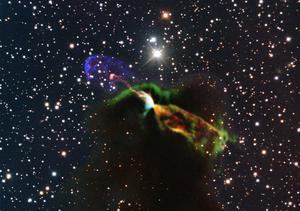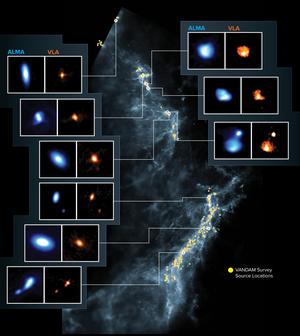Glossarbegriffe: Sternentstehung
Description: Ein Stern entsteht aus dem Gravitationskollaps eines dichten und kühlen Kerns innerhalb einer Molekülwolke. Diese kalten und dichten Molekülwolken befinden sich meistens in den Spiralarmen von Galaxien. Die Sternentstehung geht mit komplexen physikalischen Prozessen einher. Diese Prozesse laufen auf verschiedenen Größenordnungen ab und ergeben sich aus verschiedenen Effekten der Schwerkraft, des Drucks, der Strahlung, von Magnetfeldern, Turbulenzen, chemischen Reaktionen usw. Einige dieser Prozesse sind bislang noch nicht gut verstanden. Je nach Masse der ursprünglichen Molekülwolke und den Akkretionsprozessen während der Entstehungsphasen kann die Masse des Sterns zwischen 0,08 und einigen hundert Sonnenmassen liegen. Die meisten Sterne entstehen nicht als Einzelsterne sondern als Teil eines Sternhaufens. Während der Entstehungsphase bildet sich um den Zentralstern eine ringförmige Scheibe, die das Baumaterial für die Entstehung von Planeten liefert.
Zugehörige Glossarbegriffe:
See this term in other languages
Term and definition status: The original definition of this term in English have been approved by a research astronomer and a teacher The translation of this term and its definition is still awaiting approval
The OAE Multilingual Glossary is a project of the IAU Office of Astronomy for Education (OAE) in collaboration with the IAU Office of Astronomy Outreach (OAO). The terms and definitions were chosen, written and reviewed by a collective effort from the OAE, the OAE Centers and Nodes, the OAE National Astronomy Education Coordinators (NAECs) and other volunteers. You can find a full list of credits here. All glossary terms and their definitions are released under a Creative Commons CC BY-4.0 license and should be credited to "IAU OAE".
Zugehörige Medien
Witnessing the birth of a star
Bildnachweis: ESO/ALMA (ESO/NAOJ/NRAO)/H. Arce. Acknowledgements: Bo Reipurth credit link
License: CC-BY-3.0 Creative Commons Namensnennung 3.0 Unported icons
Stellar birth environment
Bildnachweis: ALMA (ESO/NAOJ/NRAO), J. Tobin; NRAO/AUI/NSF, S. Dagnello; Herschel/ESA credit link
License: CC-BY-3.0 Creative Commons Namensnennung 3.0 Unported icons










